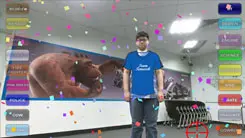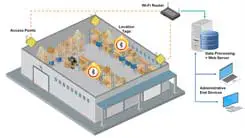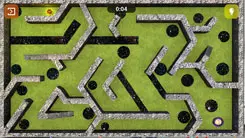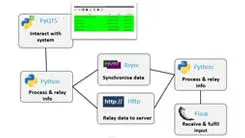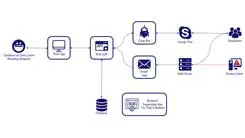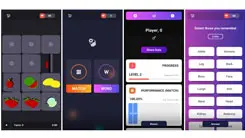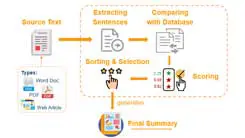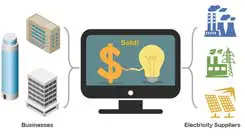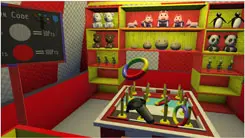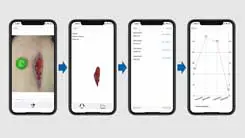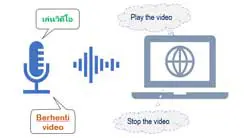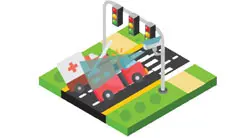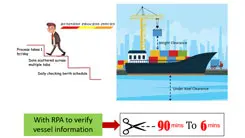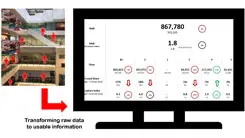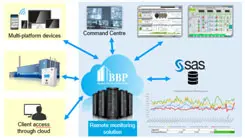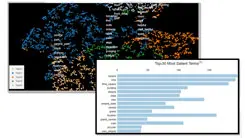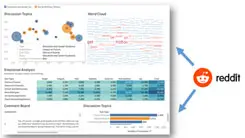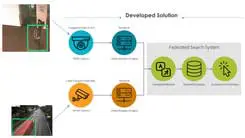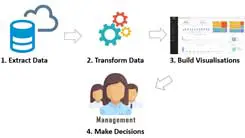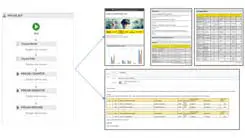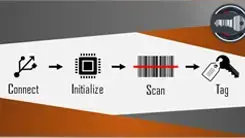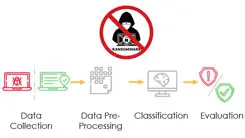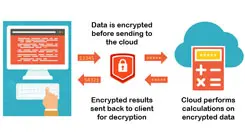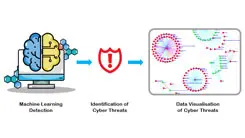
Future of Tech & Fintech
AI Sign Language Recognition
Project Background
People with hearing impairment commonly use sign language as a form of communication. However, they may face communication challenges with those who do not understand sign language. Hence, with the use of Artificial Intelligence (AI), this project aims to translate sign language into text in order to facilitate communication for those who are hearing impaired.
The application is developed using a Deep Learning model that is trained on images of American Sign Language (ASL) alphabets. The application captures the frame containing the hand gesture from the web camera in real time. Then, it analyses the image to predict and display the corresponding alphabet on the screen.
Key Benefits
- Facilitates communication - Allows hearing impaired and non-hearing impaired people to communicate using ASL.
- Enhances accessibility - Can be used as an assistive technology tool in various places including schools, offices, departmental stores, restaurants etc.
Key Technologies Used
- TensorFlow
- Keras
- OpenCV
- Python
Potential Enhancements
This application can be enhanced with the following:
- Enhancing the trained model with more components of the hand gesture as well as facial expressions.
- Developing a mobile application to run on mobile devices.
Project By
Gauransh Mathur
Qamarul Fattah B Hamdan
Industry Partner
TP-Nvidia AI Technology Centre (TP-NVAITC)
Supervisor
Ms Chew Li Peng, Jamie
Ms Hu Huimei
Amazing AR
Project Background
Have you ever wanted to try on clothes without the hassle of changing in and out of them? Check out Amazing AR where you can experience a virtual dressing room. This Augmented Reality (AR) game allows you to see how various virtual sets of clothes would look like projected onto you.
The project showcases the potential of AR technology and demonstrates what the technology can do to those who are not familiar with it. The AR clothes can follow and scaling according to your movements. The cartoonish art style makes the game eye-catching and suitable for all ages.
Key Benefits
- Entertaining – Cartoonish art style makes the game eye catching for players and draws audiences.
- Engaging – AR technology ensures a fully immersive experience as the virtual clothing follows and scales according to the tracked player.
- Interactive – Players can interact with the falling virtual confetti, allowing them to feel immersed in the AR environment.
Key Technologies Used
- Microsoft Kinect
- Unity
- Visual Studio
- Adobe Photoshop
- Maya
Potential Enhancements
This application can be enhanced with the following:
- Incorporation of custom outfit sets that allow the player to mix and match parts of certain outfits.
- More types of confetti that match the outfit’s theme.
Project Team Members
- Kwok Jun Peng, Derick (Project Leader)
- Loa Zheng Da, Ryan
- Wong Zi Jian, Nicholas
- Quek Yan Hui
- Tan Shi Hui, Valerie
Supervisor
Mr Malcolm Stuart Grant
Automated Client Onboarding Process
Project Background
Many organisations spend time and manpower completing repetitive tasks. One example is the keying and checking of data in the client onboarding process. An effective way to streamline these tasks is to use Robotic Process Automation (RPA) software like TagUI. TagUI is an open-source and cost effective RPA software that can be used to rapidly automate repetitive or time-critical tasks. By scripting a process workflow into a series of steps or conditions, TagUI is utilised to automate the entire client onboarding process.
First, the script runs the TagUI software to extract the details of various clients from their dedicated business profile. The extracted information is then captured and entered via various platforms such as the Client Relationship Management (CRM) database. Here, the information will then undergo various background checks, before the engagement letters for the clients are prepared to be sent out.
This solution is currently being used by CA Trust PAC as part of their client onboarding process.
Key Benefits
- Accuracy - Achieves accuracy and uniformity with a 99.99% reduction in errors.
- Productivity - Reduces time needed to complete the process compared to manual process approaches.
Key Technologies Used
- JavaScript
- Sikuli
- Chrome DevTools Protocol
Potential Enhancements
This application can be enhanced with the following:
- Enable visual automation to run in the background to allow for concurrent processes.
- Enable Excel support in TagUI to increase productivity.
Project By
Tan Wan Zhen
Industry Partner
- CA Trust PAC
- AI Singapore
Supervisor
Ms How Woan Ling
Bluetooth Indoor Tracking System
Project Background
GPS is a technology widely used for the tracking of items and asset management. Unfortunately, satellite-based positioning is highly inaccurate for tracking items indoors due to the lack of proper line-of-sight to GPS satellites.
The Bluetooth Indoor Tracking System solves this problem by utilising Bluetooth Low Energy (BLE) devices. This system comprises BLE tags, which are fixed onto the items or assets, and BLE gateways to track the location of the tags. When the gateways detect a signal from a tag, its location is estimated by calculating its distance from each gateway. This solution can be accessed through a web application and can easily be deployed using existing internet infrastructure.
This system is currently undergoing further development for use by e-Tag RFID Pte Ltd.
Key Benefits
- Convenient - The system is easy to use with little configuration needed. Its user-friendly web interface allows tags to be quickly added online.
- Cost-effective - By using inexpensive BLE gateways and tags, this system is affordable to implement.
- Scalable - The system allows users to add multiple gateways and tags as they see fit, giving them the option to customise its deployment from small rooms to large warehouses.
Key Technologies Used
- Bluetooth
- HTML 5
- Wi-Fi Networks
Potential Enhancements
This application can be enhanced to be compatible with a wider range of BLE gateways and tags.
Project Team Members
- Lim Leslie
- Tan Yu
Industry Partner
e-Tag RFID Pte Ltd
Supervisor
Ms Nah Swee Eng, Roselind
Games for Psychological Studies
Project Background
Games are steadily becoming more popular and widespread over the past few years. Could we use games as a medium to determine a person’s psychological traits based on the way they are played?
APD Labyrinth is a mobile application that tries to explore the possibility of determining psychology through games. By picking out the nuances of how each person plays a puzzle, APD Labyrinth is able to distinguish traits like creativity, logic, and many others. These puzzles are seemingly simple, involving getting the ball to a goal. However, the game has added features that encourage creativity in the way people play, such as allowing the ball to jump over walls by performing certain actions on the phone.
APD Labyrinth is available for download on Google Play Store and Apple App Store. It has been developed to be used as part of a psychological research study.
Key Benefits
- Accessible – This mobile application allows anyone to download, play the game and share the data of their gameplay.
- Informative – Data collected on a person shows how a person progresses in playstyle and way of thinking as they play the game.
Key Technologies Used
- Unity (Game Engine)
- Microsoft Visual Studio (IDE)
- Adobe Photoshop (Graphics & Illustration)
- Microsoft SQL (Database)
Potential Enhancements
This application can be enhanced with the following:
- More informative data that can determine a person’s psychological traits.
- Different levels that cater to different psychological traits.
- More obstacles that spur creative thinking for players.
Project Team Members
- Se Jessen (Project Leader)
- Jed Goh Yujie
- Loh Rui Jie Jason
- Yin Shengkai
Industry Partner
A*STAR Bioinformatics Institute - Antibody and Product Development (APD) Lab
Supervisor
Mr Lim Kang Woei, Sean
Google Home for Radin Mas CC
Project Background
As a part of the Smart Nation initiative, the People’s Association hopes to bring forth technologies such as Machine Learning (ML) and Artificial Intelligence (AI) into their operations. There are many residents who frequent their respective Community Clubs, and many of them often have enquiries, such as “When is your next course?” or “How much does this event cost?”. The attending staff would have to look through long lists of details to find these answers, hence delaying the process.
Radin Mas Home is an innovative solution to provide quick responses to residents’ queries. It is a voice-enabled application that can be accessed on Google Home devices or on mobile phones. All you have to do is simply ask your question and the application would recognise the voice command, instantaneously search through records and give you the appropriate answer. It has the ability to seamlessly search for information about events, courses and facilities in Radin Mas and Bukit Merah CCs. Radin Mas Home is deployed onto the Google Cloud, which allows the application to be accessible via Google Assistant, be it from your phone or from your Google Home device.
Radin Mas Home is already being used by Radin Mas residents and is also deployed on-site at Radin Mas CC. It was presented to Radin Mas’ Member of Parliament, Mr Sam Tan Chin Siong, at Radin Mas CC’s National Day Observance Ceremony 2018.
Key Benefits
- Convenient - Information can be accessed from the comfort of your home.
- User-Friendly - Virtual assistant guides you on how to use it.
- Localised - Machine Learning allows it to understand Singaporean slang and words.
Key Technologies Used
- Dialogflow
- Firebase
- Actions on Google
- Google Assistant
Potential Enhancements
This application can be enhanced with the inclusion of the Google Maps API.
Project By
Oliver Choy Chen Fung (Project Leader)
Hashirr Lukmahn
Industry Partner
A-Smart Life Pte Ltd
Supervisor
Mr David Want Yanbin
Lion City - Build and Defend a Mini Singapore
Project Background
As Singaporeans, we have heard a lot about Total Defence. But, how does it play a part in our daily lives? How can we learn more about the values of Total Defence in a fun and engaging way?
Lion City is an educational city-building mobile game that gives you the chance to build and defend a mini Singapore. The game begins with an empty port village, which you would strategically develop into a sprawling and dynamic city landscape. By managing the city's resources and increasing your citizens' happiness, you will learn about how your actions relate to Economic, Psychological and Social Defence. As the game progresses, your aim is to sustain a safe and happy nation. With the excellent gameplay and immersive mechanics, you will enjoy every second of creating the happiest city in the world!
This game was created in collaboration with the Ministry of Defence and was shortlisted as one of two finalists vying for an innovation award at SAF's Pride Day 2018.
Key Benefits
- Constructive Experience - Integrates learning points on the values of Total Defence seamlessly into the gaming experience.
- Immersive Gameplay - Intuitive and engaging gameplay with high quality graphics to appeal to players.
Key Technologies Used
- Unity3D Game Engine
- Maya Autodesk
- Microsoft Visual Studio
- Adobe Photoshop
Potential Enhancements
This application can be enhanced with the following:
- Use of servers to allow multiplayer gameplay, thus increasing competitiveness.
- Integration of combat systems to appeal to a larger audience.
Project Team Members
- Hing Zi Yang Benedict
- Jed Goh Yujie
- Lau Zhan Liang, Martin
- Soh Shing Hao
- Tan Ri Wei Gabriel
Industry Partner
Nexus, Ministry of Defence
Supervisor
Mr Nash Lin
Remote File Management System
Project Background
The Remote File Management System is a desktop application which allows users to synchronise and manage files easily across various headless devices. It is designed to make file synchronisation and management as simple and as uncomplicated as possible. Its plug and play capability allows staff with basic knowledge to access files on the remote server without any configuration or setup. The files, once amended, are synchronised effortlessly to the remote server.
This is a niche application created for a specific use case. It gives users a way to access files which are available on the remote server. These are files which most users would not have access to via normal means.
Key Benefits
- Simplicity - Allows users with basic knowledge to access files on the go effortlessly.
- Efficiency - Saves time and effort for staff to manually compare the files on the remote server with those on their device.
Key Technologies Used
- Flask
- PyQt5
- Rsync
- Python
Potential Enhancements
This application can be enhanced with the following:
- Enabling access over the Internet for ease of synchronisation for staff while working remotely.
- Adding more configuration options for advanced users to change the IP address so as to enable smooth connection with the remote server.
Project By
Kelvin Pang
Industry Partner
KLASS Engineering and Solutions Pte Ltd
Supervisor
Ms Fang-Fua Ying Huey
Request Handling & Handover with myAlpha
Project Background
myAlpha is a system comprising multiple applications, such as a web application, a web application programming interface (API), a chatbot, an email application and a backend supporting application. It serves a team of operators in the Data Centre by facilitating the process of handling service requests, and the handover of the uncompleted requests after each shift.
myAlpha integrates both the main request channel of Skype group chats and emails into a single web application. Requests and messages from the Skype group chat are retrieved with a chatbot and emails are retrieved from the mail server.
myAlpha is currently being used in a leading financial organisation in Singapore.
Key Benefits
- Increases productivity by streamlining the process.
- Reduces human error in the handling and handover of service requests.
- Introduces the ability to monitor the operator's key performance indicators (KPI) for performance appraisals.
Key Technologies Used
- C#
- ReactJS
- ASP.NET MVC- Web API
- Entity Framework
- Lync SDK
Potential Enhancements
This application can be enhanced with the following:
- Extension to other functional areas such as customer service centres.
- Upgrading of the chatbot to understand natural language to make it more user-friendly.
Project By
Seah Jin Rui
Industry Partner
A leading financial organisation in Singapore
Supervisor
Ms How Woan Ling
Test Your Memory
Project Background
Memory plays a huge part in our day-to-day lives. But do you know that they can be falsely created? Through gamification, we can measure how susceptible you are to false memory. At the same time, you get to train yourself by playing a fun game!
APD Recollection is a mobile psychological game that trains and tracks the progress of the player’s memory ability, and potential cognitive decline. The game features both spatial memory and word list memory games, which can be customised through game settings. Spatial memory game challenges the player to remember and match flipped over cards, while the word list game uses a carefully curated list of words to trick the player into falsely remembering a specific word. The game currently is localised in two languages (English and Simplified Chinese), with the aim to break the language barrier and reach broader audiences.
APD Recollection is available for download on Google Play Store and Apple App Store. It has been developed to be used as part of a psychological research study.
Key Benefits
- Convenient – Anyone can download the game to their mobile phone and play it anytime and anywhere they want.
- Informative – Players can train and track their progress through the in-built graphs.
Key Technologies Used
- Unity3D (Game Engine)
- Microsoft Visual Studio (IDE)
- Adobe Photoshop (Graphics & Illustration)
- Autodesk Maya (3D Modelling)
- Microsoft SQL (Database)
Potential Enhancements
This application can be enhanced with the following:
- Use of database to infinitely extend level count without updating the app.
- Integrate social media leaderboard system to extend influence.
Project By
- Yin Shengkai (Project Leader)
- Jed Goh Yujie
- Loh Rui Jie Jason
- Se Jessen
Industry Partner
A*STAR Bioinformatics Institute - Antibody and Product Development (APD) Lab
Supervisor
Mr Lim Kang Woei, Sean
Text Summarisation
Project Background
Text Summarisation is a web-based application designed to plough through a source text in order to condense it into a useful summary of its main ideas. With the abundance of text data from a variety of sources, web pages, news articles and blogs, this application serves to assist students when carrying out research.
Text Summarisation uses an algorithm, which extracts the useful information, then compares it against a database of nouns and verbs. Next, it scores, sorts and then selects the most salient details, before presenting it in a final summary for the user. Another important feature of the application is that it brings people together in a collaborative forum where users now have the ability to find other users with similar research areas. This provides them with a platform to share article summaries and to have discussions on their topics.
Key Benefits
- Efficiency - Creates an accurate and effective summary of a longer text document within a short time.
- Usability - Works with text information in various formats, namely, Word documents, files in PDF format, as well as web documents.
Key Technologies Used
- Python
- Bootstrap
- JavaScript
- HTML
Potential Enhancements
This application can be enhanced with the following:
- Sentiment analysis to detect the tone of the document.
- Ability for users to recommend other research materials to enhance the understanding of the topic.
Project By
James Nicolas Tan Cher Wei
Industry Partner
National Institute of Technology, Toyama College, Japan
Supervisor
Mr Alfred Teng Wee Yee
Utilities Auction Platform
Project Background
The Utilities Auction Platform is a convenient website for businesses and electricity suppliers to participate in online auctions for electricity plans. This website allows businesses to source for the most suitable electricity plans by hosting online auctions. Based on the business user's requirements, electricity suppliers would submit their bids to offer the most competitive package. The business user would then be able to sign on with the 'winning bid', or the most competitive offer, at the end of the auction.
The website's user-friendly interface and informative dashboard allows businesses to make better decisions on their electricity purchases, while providing electricity suppliers the opportunity to compete for more customers.
This online platform is currently being used by the Energy Market Company.
Key Benefits
- Convenient - Connects business users and electricity suppliers on a single platform.
- Informative - Provides real-time data so users can make better decisions on their electricity purchases.
Key Technologies Used
- Amazon Web Services Cloud Computing Services
- WordPress Open-Source Content Management System
- Katalon Studio Automation Testing Solution
- Apache Jmeter Load Testing Tool
Potential Enhancements
This application can be enhanced with the following:
- Integration of data analytics tools for business intelligence.
- Collaboration with open electricity market for public use.
Project Team Members
- Adam Mohamed Rajih
- Yan Renhui
Industry Partner
Energy Market Company Pte Ltd
Supervisor
Mr Leong Peng Kwai, John
Virtual Carnival Upgraded
Project Background
VR Carnival is a single-player environmental simulation Virtual Reality (VR) game which allows the player to experience what it is like to be in the shoes of someone at a carnival. The highly interactive carnival environment makes the game realistic and immersive.
It provides an engaging virtual reality experience where the player can explore the carnival, and then compete in various different mini games throughout the virtual carnival. The project serves the dual purpose of reviving the nostalgia of visiting a carnival while showcasing the potential of cutting-edge VR technologies.
Key Benefits
- Entertaining – Immersive graphics and gameplay ensure a fun and interactive time for the player.
- Engaging – Experience VR in a retro setting which is suitable for all ages.
Key Technologies Used
- HTC Vive
- Unity 3D
- Autodesk Maya
- Adobe Photoshop
- Substance Painter
Potential Enhancements
- Incorporation of more mini games related to a carnival setting, such as shooting games.
- Customisation of a variety of environments to capitalise on the rise of virtual tourism.
Project By
- Krismon Lie (Project Leader)
- Chua Kea Hon
- Kwok Jun Peng, Derick
- Muhammad Muazzam bin Amran
- Toh Yuan Heng
- Yeo Wei Lun
Supervisor
Mr Lim Kang Woei, Sean
Water Slide VR
Project Background
Would you like to try the water slides at Wild Wild Wet without getting wet? Then Water Slide VR is the Virtual Reality game for you! It simulates a water park environment where you can experience the fun and thrill of being at a water park in the comfort of your home.Water Slide VR features authentic slides which are re-created based on actual slides found at Wild Wild Wet @ Downtown East. As you explore the park, you can try popular slides like the Ular-lah, or brand new attractions like the Royal Flush. While riding down the slides, you can also play fun games like shooting targets or popping balloons. The park also includes carnival booths where you can play simple arcade-style games.
This game was created in collaboration with NTUC Club to bring attention to Wild Wild Wet’s recent expansion and the integration of new slides. It was showcased to the public at Downtown East’s 30th anniversary event on 10 November 2018.
Key Benefits
- Immersive – Allows players to experience the fun and thrill of actual slides in Wild Wild Wet @ Downtown East.
- Constructive – Contributes to the promotional campaign to publicise Wild Wild Wet’s latest attractions to a wide audience.
Key Technologies Used
- Unity Game Engine
- SteamVR (HTC Vive VR)
Potential Enhancements
This application can be enhanced with the following:
- Multi-layered playable games.
- Accurate portrayal of the entire Wild Wild Wet park.
Project Team Members
- Chiok Wei Wen, Gabriel (Project Leader)
- Fong Jia Hao, Oscar
- Lim Ji Xuan, Shane
- Muhammad Azri Bin Azemi
- Travess Tan Chee Khang
Industry Partner
NTUC Club
Supervisor
Mr Nash Lin
Wound Monitoring App
Project Background
What is the size and area of the wound? Is the wound healing properly? These are some common questions asked by patients with serious wounds, especially after major surgery. The APD Skin Monitoring App removes any doubts patients would have by providing them with an accurate area measurement of their wound.
The APD Skin Monitoring App is a mobile application which helps users to monitor the size and area of their wound and to track the progress of its healing. It uses a standard coin size as the source of reference to eliminate the need for estimated measurements by patients. This app then displays the data in the form of a graph chart. In addition, the image overlay feature displays images of the wound on top of one another. This provides users with a visual indicator of how their wound has healed over time.
The APD Skin Monitoring App was developed for personal use and is available for download on Google Play Store and Apple App Store. It has already been downloaded by users from various countries including Australia and Singapore, with most of its downloads coming from the USA.
Key Benefits
- Convenience - Removes the need for human estimation of the wound size.
- Cost and time efficiency - Allows caregiver to keep track of the patient's progress without the need for regular visits to the doctor.
Key Technologies Used
- Charts and Hello Chart
- SQLite
- Open CV
- Java/C++/Objective C and Swift Programming
Potential Enhancements
This application can be enhanced with the following:
- Storage of data in the cloud to provide doctors with immediate access and the ability to carry out real-time monitoring of the patient's healing.
- Ability to provide the patient with prescriptions for medicine based on the real-time progress of the healing of the wound.
Project By
Yong Yu Wei Kenneth
Industry Partner
A*STAR Bioinformatics Institute - Antibody and Product Development (APD) Lab
Supervisor
Mr SankaraRajulu Sundara Rajulu
Growth & Opportunities in AI & Analytics
A Multilingual Voice Assistant for the Workplace
Project Background
Voice assistant technologies are commonly being used to aid in daily tasks, but there are limitations to the languages that can be recognised. Furthermore, with the advancement of these tools, how can they be used to unlock productivity in a multilingual workplace?
ENC.IQ is an AI-enabled workplace digitalisation system that can aid in executing common tasks in a work environment, with a unique capability of processing non-English commands. It comprises an iOS mobile application and relevant smart devices. Using Natural Language Processing, it translates the voice commands from the user’s preferred language into English, and then executes the actions via the IoT-connected devices. For example, a user may give a ‘lights off’ command in Malay, and the system would recognise the translated command and proceed to switch the lights off accordingly.
This system can currently process commands in the Malay and Thai languages, and is being used in Accenture to improve productivity in the workplace.
Key Benefits
- Improved digitalisation at the workplace.
- Increased productivity via the voice assistant which automates processes.
Key Technologies Used
- Language Understanding Intelligent Service (LUIS)
- Google Assistant
- SiriKit
- Google Translation API
- If This Then That (IFTTT)
- Custom RESTful APIs
- Twilio (PaaS)
Potential Enhancements
This application can be enhanced with the following:
- Enable training of the voice assistant with a mixture of languages spoken together.
- Enable the voice assistant to learn through context-based learning.
Project By
Ya Min Thu
Industry Partner
Accenture Pte Ltd
Supervisor
Dr Edirisinghe, EM Nalaka
Adaptive Traffic
Project Background
An ambulance reaching its destination on time can be the difference between life and death. Hence, in 2017, the Singapore government announced that emergency services can legally run red lights and make unauthorised U-turns. However, this could inadvertently cause accidents when these emergency vehicles do so.
Adaptive Traffic is an object detection software trained using deep learning technology. It detects emergency vehicles on the road and has the potential to control traffic lights to turn them in favour of these emergency vehicles. Thus, emergency vehicles can reach their destinations in a faster and safer way.
This project was shortlisted for the final round of the Young Sustainability Innovators’ Challenge 2018 organised by the University of Newcastle, Australia.
Key Benefits
- Optimising Traffic Light Timings – Oncoming emergency vehicles could be detected and traffic light timings could be adjusted to ensure a smooth journey.
Key Technologies Used
- Deep Learning
- YOLO Object Detection Model
Potential Enhancements
This project can be enhanced with the following:
- Using a more complex model for object detection.
- Training the system with more relevant data.
- Using higher quality data and increasing data count for higher accuracy.
Project Team Members
- Das Arpitt
- Ong Zhi Ying, Adrian
Supervisor
Ms Ler Lay Guat
Automated Verification of Vessel Information
Project Background
Whenever a vessel is scheduled to arrive in Singapore’s port, the Port of Singapore Authority (PSA) would assign berths to the vessel. To do so, staff would have to identify the vessel and gather relevant data about the vessel in order to assign a suitable berth for optimal allocation of lots. Although such information is declared by the vessel’s agent, this time-consuming verification process is needed for accuracy.
The use of a Robotic Process Automation software fully automates this business process. With this software, relevant data is extracted automatically and processed by an algorithm to generate a report. The report is then sent to the respective managers via email and highlights any inaccuracies for the managers to perform the necessary follow-up actions.
This solution is currently being used by PSA to automate the process of verifying vessel information.
Key Benefits
- Convenient – The process is fully automated and runs on a fixed schedule.
- Accurate – Without the need for manual input, human error is eliminated and accuracy in data is increased.
- Efficient – The use of RPA to automate this process saves several man-days per year.
Key Technologies Used
- Robotic Process Automation software, UiPath
- UiPath Studio (coding)
- UiPath Robot (robot)
Potential Enhancements
This application can be enhanced by using QlikView to generate informative and interactive dashboards on recurring data.
Project By
Renee Lee Sok Yee
Industry Partner
PSA Corporation Limited
Supervisor
Ms Ramasamy Sakthivelu Maheswari
Fraud Detection Using Data Analytics
Project Background
Do you know of companies facing issues in:
- detecting fraudulent cases in transport claims;
- detecting duplicate payments in invoices;
- verifying transport claim distances manually?
These fraud issues could easily be resolved using SAS Visual Analytics and UiPath. UiPath uses robotic process automation (RPA) to replicate manual business processes. First, it picks up key travel information from Microsoft Excel files, then verifies transport claim distances via Google Maps. The data is then visualised using SAS Visual Analytics, enabling users to quickly detect anomalies in transport claims
Key Benefits
- Secure – Detects fraudulent claims and duplicate payments.
- Efficient – Improves efficiency by replacing manual processes.
Key Technologies Used
- SAS Visual Analytics
- UiPath
Potential Enhancements
This project can be enhanced with the following:
- Interactive dashboards which can be accessed via mobile phones.
- Use of robotic process automation to replicate other types of manual business processes.
Project By
Jeremy Ng Tze Boon
Supervisor
Ms Tang Iman
Retail Analytics Using Smart IoT Sensors
Project Background
With the rising trend of e-commerce, brick-and-mortar retailers are facing a meltdown, where even bigger brands are not spared. The competition is real, especially when these online stores provide affordable services as well as convenience. How can physical stores do more to attract potential customers?
Businesses can harness retail analytics to improve their marketing campaigns by understanding customers’ behaviour. By blending demographic data with information such as shopper habits and preferences, companies can be in a better position to succeed when attempting to predict business and consumer needs. For example, the IoT sensors may detect areas of low traffic within a retail space. Then, retailers could analyse this data and come up with strategies to encourage customers to frequent these areas.
This project is currently being used to analyse customer traffic in a retail mall in Singapore.
Key Benefits
- Customer Profiling – Create a profile of likes and dislikes of customers by using gathered data of customer behaviour.
- Smart Business Decisions – Make informed decisions to sell the most relevant services to customers based on their preferences.
Key Technologies Used
- Smart IoT Sensors
- Modcam Cloud
- R Studio
- Microsoft Excel
Potential Enhancements
This application can be enhanced with the following:
- Optimising inventory management to emphasise the products customers need, reducing wasted space and associated overhead costs.
- Carrying out marketing campaigns strategically to cater to the needs of customers.
Project By
Sherin Begum Cheah Mohamed Iqbal
Industry Partner
Frost & Sullivan
Supervisor
Mr Lim Kok Yau
Saving Energy with Predictive Analytics
Project Background
Air conditioning systems account for a major part of energy consumption in commercial buildings. This consumption is influenced by several factors such as ambient conditions and temperature.
This project aims to improve the energy efficiency of air conditioning systems by collecting ambient data from sensors. With the data, the algorithm would be able to identify the most efficient settings for the air conditioner at different times of the day using predictive analytics and machine learning techniques.
This solution is currently being used by Barghest Building Performance Pte Ltd to improve their use of energy.
Key Benefits
- Improved Chiller Plant Efficiency – Without replacing old chillers, HVAC* systems can also be optimised to achieve 30% improvement in efficiency.
- Increased Energy Savings – Reduced energy consumption translates to dollar savings for the organisation.
Key Technologies Used
- SAS Enterprise Guide
- SAS Enterprise Miner
Potential Enhancements
This application can be enhanced with the following:
- Adding more automation to the entire process.
- Tracking performance of the model over time.
Project By
Toh Ying Hui
Industry Partner
- SAS Institute Pte Ltd
- Barghest Building Performance Pte Ltd
Supervisor
Mr Surojit Dutta
Topic Modelling Website
Project Background
Reviews, discussions, and social media posts are a few of the many avenues where businesses capture customer data. However, many of these text-based data are unlabeled, which makes the data difficult to explore and analyse.
The topic modeling website is a website which labels and sorts raw data into selected topics. Users upload raw data extracted from different sources, and based on the users’ preferences, the website then organises the data according to their labels or topics.
The website is hosted on Flask, a Python micro web framework, and is used by Gowild Singapore in their corporate website.
Key Benefits
- Easy to use data exploration – With an interface like a website integrated with an optimised topic modeling model, it is easy for users to explore their datasets.
Key Technologies Used
- Python
- Flask
- scikit-learn Non-negative Matrix Factorization (NMF)
- pyLDAvis
- t-SNE
Potential Enhancements
This application can be enhanced with the integration of classifier and sentiment analysis models to perform further analysis, hence adding more value to businesses.
Project By
Jasmine See Yu Ting
Industry Partner
Gowild Singapore Pte Ltd
Supervisor
Ms Imanishi Nami
Understanding Netizens' Sentiments on Reddit
Project Background
Would you like to find out what netizens are talking about with just a click of your mouse? The Reddit Webscraper can help you. The Reddit Webscraper is an automated web crawler designed to extract data from Reddit discussion forums within seconds.
This project uses a Topic Modeller to mine data from across different threads and forums to identify clusters of similar words associated to a topic. Additionally, it uses Emotional Analytics to help identify the emotions portrayed by netizens. This allows a user to understand how netizens feel about any particular issue.
This solution is currently being used by the Ministry of Education to analyse netizens’ sentiments on education.
Key Benefits
- Efficient – The automated webscraper can extract relevant information from the internet within seconds.
- Flexible – The webscraper can be used for different social media platforms with minor changes to the codes.
Key Technologies Used
- R Studio
- Tableau
- Python
Potential Enhancements
This application can be enhanced with the following:
- Machine Learning could be implemented to scrape specific communities on a weekly/monthly basis.
- Edits could be made to the R code to teach the programme to understand and identify written nuances such as joy, anger or sarcasm for Emotional Analytics.
- Minor changes to the Python Code would allow the crawling of information on different Social Media Sites.
Project By
Kenneth Chan Junheng
Industry Partner
Ministry of Education
Supervisor
Mr Andrew Chong
Universal Search System for Video Analytics
Project Background
Video analytics has recently gained traction in several industries such as retail, aviation, and law enforcement among others. By finding images across multiple video files from different camera sources, agencies and companies can extract information relevant to them to uncover insights and patterns. Many government organisations such as the Land Transport Authority (LTA) and Singapore Police Force (SPF) are also leveraging video analytics to process their camera feeds to extract insights. With the different nature of data each agency handles, video analytics systems and metadata tend to differ. This has made data sharing between agencies impossible.
The Universal Search System for Video Analytics is a type of middleware used to translate video analytics data from various agencies and provide a unified view of records across all agencies. This project facilitates the translation of different metadata into a consistent format in a unified database.
This system is currently being used in several government agencies in Singapore.
Key Benefits
- Enhanced communication – Makes data sharing between government agencies feasible.
- Useful insights – Generates additional data which can be used for analysis to potentially create useful insights.
Key Technologies Used
- Object Relational Mapping (ORM) Database with SQL Alchemy
- Python Watchdog Library
- Restful API with Flask Server
- MySQL Database
- React-Bootstrap User Interface (UI)
Potential Enhancements
This application can be enhanced with the following:
- Creation of user accounts for authorisation and authentication purposes.
- Subscription of notifications to prompt users.
- Integration of Google Maps Street View to visualise locations.
Project By
Ong Zhi Ying, Adrian
Industry Partner
Government Technology Agency (GovTech)
Supervisor
Mr Lim Kok Yau
User Experience Service Metrics
Project Background
With an impending IT chargeback policy in the organisation, the over-simplistic reports produced by the helpdesk team lacked detailed information on the IT resource usage by each department. Hence, decision-makers found difficulty in understanding each department’s IT resource usage.
User Experience Service Metrics is a data pipeline comprising a web application and a backend executable data sorter programme. It extracts data from an IT Service Management platform to generate a report on service requests raised by departments, offices and users. Then, it cleans and transforms the data into an appropriate format for analysis. The cleansed data is then presented via charts through the web application. This automated process allows business owners and managers to make more informed decisions on IT resource usage.
This solution is currently being used in a leading financial organisation to better understand and analyse the IT service requests raised by staff.
Key Benefits
- Improved operational efficiency — Automates the process of creating reports, allowing staff to focus on higher value activities.
- Increased visibility — Provides granular information on resource usage across each business unit to facilitate the implementation of IT chargeback policy.
Key Technologies Used
- C#
- JavaScript
- HighCharts
Potential Enhancements
This application can be enhanced with the following:
- Include additional data streams to facilitate root cause analysis.
- Trigger an automated notification to business unit leaders when their resource usage approaches the threshold set by management.
Project By
Tan Boon Yeow
Industry Partner
A leading financial organisation in Singapore.
Supervisor
Mr Lim Beng Kee, Ryan
Workplace Automation
Project Background
Workplace Automation is a desktop-based application which serves to automate repetitive tasks which are carried out on a regular basis.
Workplace Automation utilises UiPath, a Robotics Process Automation (RPA) software, Microsoft Excel and Microsoft Outlook to automate two processes. The first process is to create monthly newsletters containing latest data on clients, while the second process serves to generate data which is then used to create weekly emails for a set list of recipients. A process which would normally take three working hours can now be completed within 40 minutes.
This solution is currently being used to improve work processes in Ernst & Young LLP (Singapore).
Key Benefits
- Convenience – With one click, staff can activate the automation process and concurrently work on other tasks.
- Accuracy – With the use of RPA, human error can be eliminated leading to a higher level of accuracy in tasks.
Key Technologies Used
- UiPath
- Microsoft Excel
- Microsoft Outlook
Potential Enhancements
This application can be enhanced with the following:
- Use of machine-learning model to enhance the RPA.
- Use of Power BI to generate interactive dashboards for process automation.
Project By
Lauren Ng
Industry Partner
Ernst & Young LLP (Singapore)
Supervisor
Dr Edirisinghe, EM Nalaka
Next-Gen Security Evolution
2FA Key Management System with Barcode Integration
Project Background
In today’s ever-changing cyber landscape, conventional passwords are no longer safe. The solution is to implement Two-Factor Authentication (2FA) which acts as an added layer of protection during authentication. 2FA works by giving a user a cryptographic key, in the form of an SMS or physical device, which is needed for authentication.
The Key Management System helps IT Administrators to manage cryptographic keys in a 2FA system developed by ST Engineering Electronics for a product called the Black Computer. The Black Computer is a secure computer which uses physical tokens in the form of USB devices that must be inserted into the computer for authentication. This system uses barcode scanning technology to help save time and improve its usability.
The Key Management System adds value to businesses by improving the manageability and traceability of cryptographic tokens through automation, which help to reduce manpower costs. This system plays a pivotal role in the management and maintenance of a 2FA system for the Black Computer in preventing unauthorised access.
This system is still in development to be used by ST Engineering Electronics in the near future.
Key Benefits
- Efficient Provisioning of Keys – A secure and simple way to provision cryptographic tokens to staff in an organisation.
- Well-Organised System – An easy-to-manage token allocation process.
Key Technologies Used
- .NET Framework
- Public Key Cryptography Standard 11 (PKCS11)
- AES Encryption
Potential Enhancements
This application can be enhanced with the following:
- A central database to increase accessibility of the application for multiple administrators.
- Certificate support to improve security features of authentication process.
Project By
Zafran Bin Azhar
Industry Partner
ST Electronics (Info-Security) Pte Ltd
Supervisor
Mr Edmund Wee
Detecting Ransomware Using Behavioural Analysis and Machine Learning
Project Background
Ransomware is projected to remain a big threat to users. Hence, its prevention requires fast and accurate detection. Current antivirus solutions use signature-based detection, which identifies attacks by looking for specific information of known threats. However, this is ineffective when dealing with new variants of ransomware, leading to loss of data and trust.
This project is a preliminary study which seeks to understand the behaviour of ransomware and how to detect them using machine learning. Data on ransomware and their behaviour were collected using Progger software and processed using machine learning algorithms. The results of the tests were compared to derive the most effective detection method. The findings show that the integration of behavioural-based data and machine learning can be effective in detecting both known and unknown threats. This can contribute to the future development of detection systems.
Key Benefits
- Deeper understanding of new methodology – This study covers in-depth information on the potential of using machine learning to detect ransomware.
- Proven results – The findings clearly show the exact classifier which is the most accurate and efficient, hence aiding further development of possible solutions.
Key Technologies Used
- Progger
- Scikit-Learn
- Waikato Environment for Knowledge Analysis (WEKA)
Potential Opportunities
The study could be expanded further to explore:
- Nuanced labelling to examine more complex behavioural activity of ransomware.
- Automated cleaning of Progger data to minimise processing of unnecessary data.
Project By
Dian Maisara Bte Muhamed Iskandar
Industry Partner
Cyber Security Researchers of Waikato, University of Waikato
Supervisor
Mr Lim Chee Yong
Improving Cloud Security using Homomorphic Encryption
Project Background
Are you worried about the security of your data stored in the cloud? What if you wanted to make calculations with confidential financial information?
Homomorphic encryption is an innovative method of performing calculations on information in a highly secure way. Existing methods of encryption require data to be decrypted first before edits can be made. However, with homomorphic encryption, the edits can be done while the information is still scrambled. This project is a proof-of-concept to show the successful and accurate use of homomorphic encryption to perform simple mathematical calculations on secure data. This technique can potentially be used in industries handling highly confidential data, such as the healthcare and government sectors.
Key Benefits
- Increased Security of Cloud Services: Makes use of the computing power of the cloud while keeping the encrypted data secure.
- Reduced Risk of Data Breaches: Protects encrypted data from being exposed while calculations are being performed.
Key Technologies Used
- C/C++
- Fast Fully Homomorphic Encryption over the Torus (TFHE)
- Ubuntu
- OpenMP
- OpenMPI
Potential Enhancements
This application can be enhanced with the following:
- Implementation of the Graphical User Interface (GUI).
- Use of Graphics Processing Unit (GPU) to improve performance.
- Further optimisations to increase speed of calculations.
Project Team Members
- Jovan Sie
- Kee Ruitao
- Rhys Wong
Supervisor
Dr Yap Chern Nam
Using Machine Learning to Identify Cyber Threats
Project Background
Analysts who work in a Security Operations Centre (SOC) are constantly monitoring security events in an organisation’s IT network. In many cases, they would have to spend time analysing unusual cyber activity to determine if such activity was a genuine threat.
SEAL is a System for Enterprise Anomaly detection. It is an integrated solution that uses Artificial Intelligence to efficiently identify cyber incidents. SEAL analyses the activity by processing data from system logs and network traffic. Using machine learning algorithms, it detects unusual cyber activity and identifies if the specified activity is a security threat. Then, it displays the results in a user-friendly dashboard. This allows SOC analysts to be alerted to potential cyber attacks in a faster way.
This solution is still in development to be used by ST Engineering Electronics in the near future.
Key Benefits
- Detection efficiency: Identifies cyber threats in near real-time.
- Data visualisation: Displays data in a user-friendly layout to aid investigations.
Key Technologies Used
- Machine Learning
- Black Computer
- Django
- Docker
- Node.js
Potential Enhancements
This application can be enhanced with a more interactive Graphical User Interface (GUI).
Project By
Tan Yi Ren
Industry Partner
ST Engineering Electronics Pte Ltd
Supervisor
Mr Edmund Wee

We use cookies to offer you a better browsing experience. By continuing, you are agreeing to the use of cookies on your device as described in our privacy statement.

